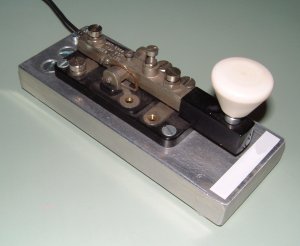
Here is the famous international Morse code as used by many hams. The "dits" and "daahs" in brackets are a way to pronounce letters as they sound in order to make learning easier.

| A |   |
(dit daah) |
| B |     |
(daah dit dit dit) |
| C |     |
(daah dit daah dit) |
| D |    |
(daah dit dit) |
| E |  |
(dit) |
| F |     |
(dit dit daah dit) |
| G |    |
(daah daah dit) |
| H |     |
(dit dit dit dit) |
| I |   |
(dit dit) |
| J |     |
(dit daah daah daah) |
| K |    |
(daah dit daah) |
| L |     |
(dit daah dit dit) |
| M |   |
(daah daah) |
| N |   |
(daah dit) |
| O |    |
(daah daah daah) |
| P |     |
(dit daah daah dit) |
| Q |     |
(daah daah dit daah) |
| R |    |
(dit daah dit) |
| S |    |
(dit dit dit) |
| T |  |
(daah) |
| U |    |
(dit dit daah) |
| V |     |
(dit dit dit daah) |
| W |    |
(dit daah daah) |
| X |     |
(daah dit dit daah) |
| Y |     |
(daah dit daah daah) |
| Z |     |
(daah daah dit dit) |
| 1 |      |
(dit daah daah daah daah) | Sometimes abbreviated with A |
| 2 |      |
(dit dit daah daah daah) | Sometimes abbreviated with U |
| 3 |      |
(dit dit dit daah daah) | Sometimes abbreviated with V |
| 4 |      |
(dit dit dit dit daah) | |
| 5 |      |
(dit dit dit dit dit) | |
| 6 |      |
(daah dit dit dit dit) | |
| 7 |      |
(daah daah dit dit dit) | Sometimes abbreviated with B |
| 8 |      |
(daah daah daah dit dit) | Sometimes abbreviated with D |
| 9 |      |
(daah daah daah daah dit) | Sometimes abbreviated with N |
| 0 |      |
(daah daah daah daah daah) | Sometimes abbreviated with T |
| . | Period |       |
(dit daah dit daah dit daah) |
| , | Comma |       |
(daah daah dit dit daah daah) |
| : | Colon |       |
(daah daah daah dit dit dit) |
| ? | Question mark |       |
(dit dit daah daah dit dit) |
| ' | Quote |       |
(dit daah daah daah daah dit) |
| – | Hyphen or minus |       |
(daah dit dit dit dit daah) |
| / | Slash |      |
(daah dit dit daah dit) |
| ( | Left bracket |      |
(daah dit daah daah dit) |
| ) | Right bracket |       |
(daah dit daah daah dit daah) |
| " | Double quotes |       |
(dit daah dit dit daah dit) |
| = | Equals |      |
(daah dit dit dit daah) |
| + | Plus or end of message |      |
(dit daah dit daah dit) |
| × | Cross |     |
(daah dit dit daah) |
| SN | Acknowledgment |      |
(dit dit dit daah dit) |
| K | Transmission request |    |
(daah dit daah) |
| AS | Wait |      |
(dit daah dit dit dit) |
| SK | End of transmission |       |
(dit dit dit daah dit daah) |
| KA | Start of transmission |      |
(daah dit daah dit daah) |
| Error |         (*) (*) |
(dit dit dit dit dit dit dit dit) |
(*) Eight or more dots.
| è |      |
(dit dit daah dit dit) |
| à |      |
(dit daah daah dit daah) |
| ä |     |
(dit daah dit daah) |
| ö |     |
(daah daah daah dit) |
| ü |     |
(dit dit daah daah) |
| ch |     |
(daah daah daah daah) |
It's common to express duration of Morse signals as a function of the length of a dot according to the following rules:
Of course those rules are not strict at all (especially when using a straight key) and some hams prefer using longer dashes of 3.5 or 4 dots long instead of 3.
The keying speed is often expressed in words per minute (WPM), and since the length of the letters is not constant the reference word "PARIS" is commonly used:

As shown in the above diagram, considering spaces between letters after the word itself, the word "PARIS" is exactly 50 dots long, and of course is 5 letters long. Therefore a keying speed of 30 WPM (words per minute) will be equivalent to 150 LPM (letters per minute), each dot will be 40 ms long and each dash will be 120 ms long.
In order to have an idea of the speed of the code here are some examples (.wav files) of the word "PARIS" at different speeds:
| [1] | OFCOM - Office fédéral de la communication. Prescriptions concernant les radioamateurs. Section concessions de radiocommunication, Rue de l'Avenir 44, CH-2503 Bienne, 2001, Appendice 5. |
| [2] | Carlo Amorati I4ALU. Manuale di radiotelegrafia. C&C - Edizioni Radioelettroniche, 1995. |
| [3] | The ARRL Handbook for Radio Communications 2002, Seventy-ninth edition. American Radio Relay League, 2001, Page 12.12. |
| Home | Electronics | Index | Page hits: 044443 | Created: 10.1999 | Last update: 10.2013 |